
Time changes, history advances day by day, and then the world evolves. Without reliable evidence, no one knows about the original life and society during the past 5000 years of China. Luckily, although we are unfamiliar with the historical processing, certain answer lies in the great museums we will introduce below. Follow the footprint of history, authentic and vivid scenes of ancient life and economy ultimately come to light along with more understanding of the gorgeous history and culture we had.
Every cultural heritage left from ancient time is a genetic code recording vein of Chinese nation; every museum is a genetic treasure guarding Chinese civilization. To protect and inherit the essence of human culture, the museums are the significant bridge connecting the past, the present and the future. Like the history tells authentic stories about the past, relics of museums are the best witness to unlock the mystery of ancient China.
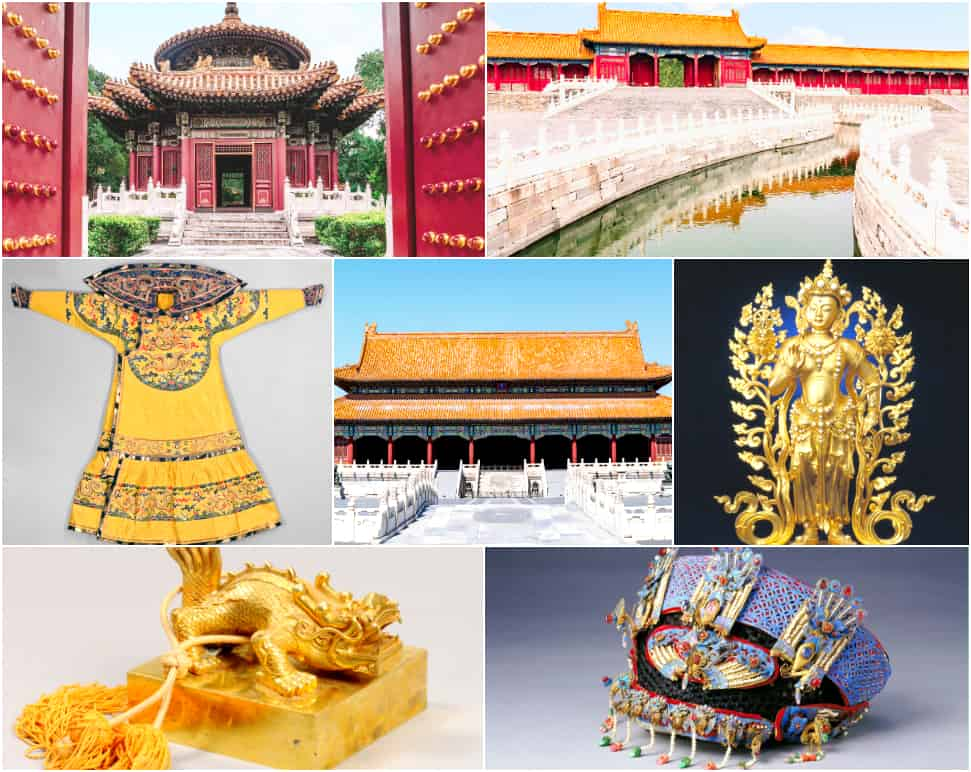
Built in: October 10, 1925
Area: more than 723,600sqm (Width & Length: 753m X 961m)
Collection: 1,862,690 pieces (sets)
Masterpieces: Riverside Scene at Qingming Festival, Picture of The Ode of the River Goddess, Penta- Bull Map of Tang Dynasty (the earliest paper painting), Picture of Steps from Tang, Sketch of Rare Birds from the Five Dynasties, Han Banquet Map, wonderful paintings from Tang Yin...
Open Hours: 08:30~17:30 (April~October) & 08:30~17:00 (November ~March); closed on Mondays.
Ticket: 60RMB in High Season(April ~ October) & 40RMB in Off Season (November ~ March); 10RMB per person for Treasure Hall (entrance from Palace of Peace and Longevity) and the Clock Museum (Fengxian Palace) separately; children under 1.2m are free of charge.
Location: No.4 Jingshan Front Street, Dongcheng District, Beijing City.
Recommended Visiting: 2hrs ~ one day
Built on the largest and most well-reserved wooden structure palace complex - Forbidden City of Ming and Qing Dynasty, the Palace Museum is a special World Cultural Heritage, the biggest comprehensive art museum of ancient Chinese culture and the one and only pride for Chinese nation, precious cultural legacy for all human beings. Today, the huge royal palaces are giant treasury with countless valuable gems from Ming & Qing Dynasty, also the living fossil of Chinese imperial history.
Both served as the protection administration of the Forbidden City and collecting, researching and exhibition institution of all ancient Chinese cultural and historical relics from Ming & Qing Dynasty and etc, the Palace Museum has the most complete and best quality collections of 25 main categories up to over 1,800,000artifacts, 8,000 first grade items.
After five hundred years of vicissitudes of history, the imperial palaces finally opens to the public. Most recommended tour route is follow the central axis and visit palaces or halls on both sides. The Period Halls, a popular exhibition method, are the unique presentation of royal palaces in original forms, Cining Palace Garden (Garden of Compassion and Tranquility), Shoukang Palace( Palace of Longevity and Health), Taihe Palace (Hall of Supreme Harmony), Qianqing Palace (Palace of Heavenly Purity) and more are the perfect integration of delicate preserved-relic and ancient architectures. Apart from palace visiting, there are ten permanent galleries exhibiting various types of treasure, including Gallery of Ceramics, Calligraphy &Painting, Bronze, Treasure, Qing Imperial Opera, Jade(closed now), Sculpture, Historic Architecture, Hall of Clocks, Digital Gallery and Kulangsu Gallery of Foreign Artifacts from the Palace Collection. Besides, Palace Museum holds some excellent temporary exhibitions on special cultural themes, out-of-town exhibitions to display marvellous collections of Palace Museum, make culture exchange with other cities.
Notice:
1. Since July 2, 2011, the Palace Museum operate south-north one way tour route, only entrance is the Meridian Gate (South Gate) and exit from Shenwu Gate in the north or Donghua Gate in the east.
2. No smoking within any place in Palace Museum, no scribbles, and no flashlight and tripod when taking photos in exhibition halls.
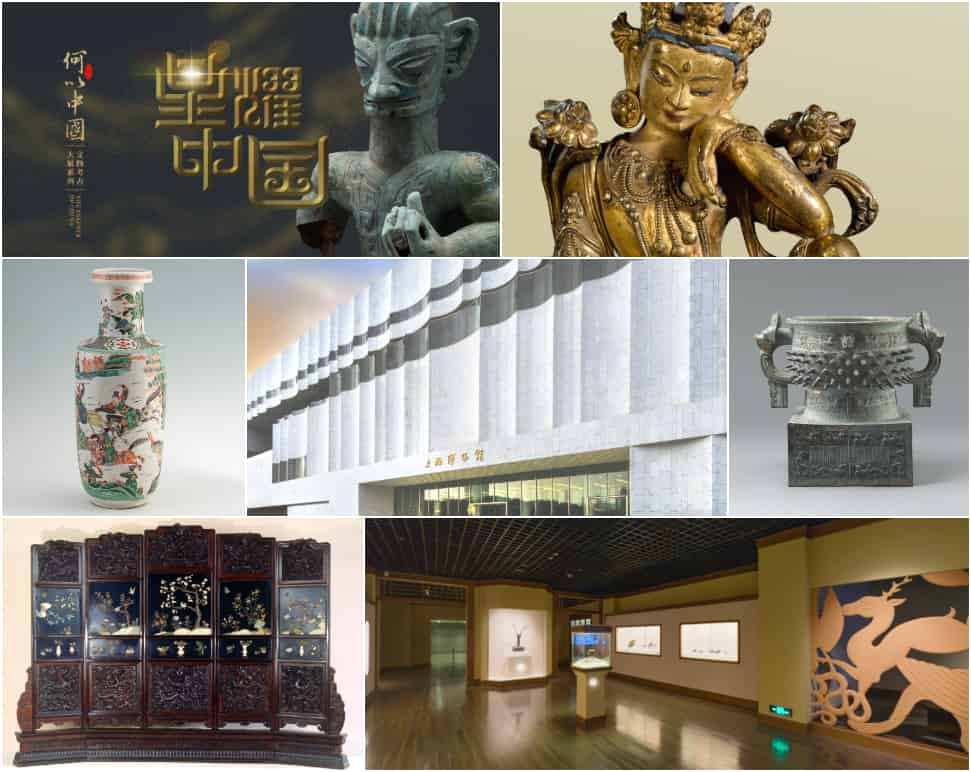
Built in: October 12,1996
Area: 39,200 sq m
Collection: 120,000 pieces, 717 first grade cultural relics.
Masterpieces: Big Grams Tripod, Shangyang Fangsheng (measuring vessel in middle Warring States Period), Silk Painting of Ducks Swimming in Lotus Pond, De Ding, Mao Ding and Tiger Gui from Western Zhou, Ancient Copper Coins, Pottery, Jades...
Open Hours:09:00~17:00; closed on Mondays.
Ticket: Free Ticket
Location: No.201 Renmin Avenue, Huangpu District, Shanghai City.
Recommended Visiting: 3 ~ 4hrs
Enjoying a high reputation at home and abroad, Shanghai Museum is a large gallery of ancient Chinese arts with more than one hundred thousand cultural treasures, features in fantastic collections of bronze, chinaware, calligraphy and paintings. Situated in the south of downtown People Square of Shanghai, the newly built dome-shaped building with square base looks magnificent artfully merging the traditional culture and contemporary style, there are three exhibition halls and twelve special halls in the four floors above and two underground.
A exhibition hall and Exhibitions of Ancient Chinese Bronze (1200 sq m) and Sculpture (640sq m) are located on the first floor where more than 400 exquisite bronzes displayed in elegant wooden cabinet under deep green ambience and over 120 figurines of woodcarvings, pottery sculptures, gold and bronze Buddha statues from Nothern Wei, Sui and Tang Dynasty. Most precious artifact is the stone Buddha statue without one arm from Tang Dynasty, imperfect but praised as Oriental Venus. On the second floor, there is another exhibition hall and Gallery of Ancient Pottery (1300sq m), the later presents more than 500 porcelains in different types and dynasties including polychrome pottery and grey pottery from the Neolithic Age, celadon in Eastern Han, tri-color glazed ceramics during Tang and imperial ceramic in Song, Jin and Liao Dynasty and highlighted part - ancient blue china during Shang, Zhou, Spring & Autumn Period and Warring States Period. Get up to floor three, there goes to the Art Gallery of Ancient Chinese Painting (1200 sq m), Seals (380sq m) and Calligraphy. Writings from Wang Xianzhi, Tang Gaoxian and Huai Su are the masterpieces, drawing of Tang Sunwei, Song Liangkai among the 120 relics are rare treasures of China. Gallery of Ancient Chinese Seal is the pioneer pavilion specialized in more than ten thousand classic and artistic seal boutiques.
The highest location on floor four offers most galleries of National Craft (700sq m), Ancient Chinese Jade, Ming & Qing Furniture (700sq m), Chinese Ancient Currency (730sq m) to have a fast acquaintance of diversity of ancient livings. About 600 exotic ethnic handcrafts, clothes, silk embroideries, metalwork, carvings, pottery, lacquer, bamboo weaving and masks are shown in the Gallery of National Craft. And the Ancient Coin Room of Silk Road are presented with more 7000 distinctive coins of various material and dynasties to reveal the processing of Chinese currency and history of economic exchange between China and foreign countries. In the furniture hall, more than 100 sets of delicate ancient house furnishings from two noble family of Wang Shixiang, Chen Mengjia during Ming & Qing Dynasty are the top level of decoration in appearance, taste and skill for Chinese housing.
Notice: Daily visitor of Shanghai Museum is limited within 5000.
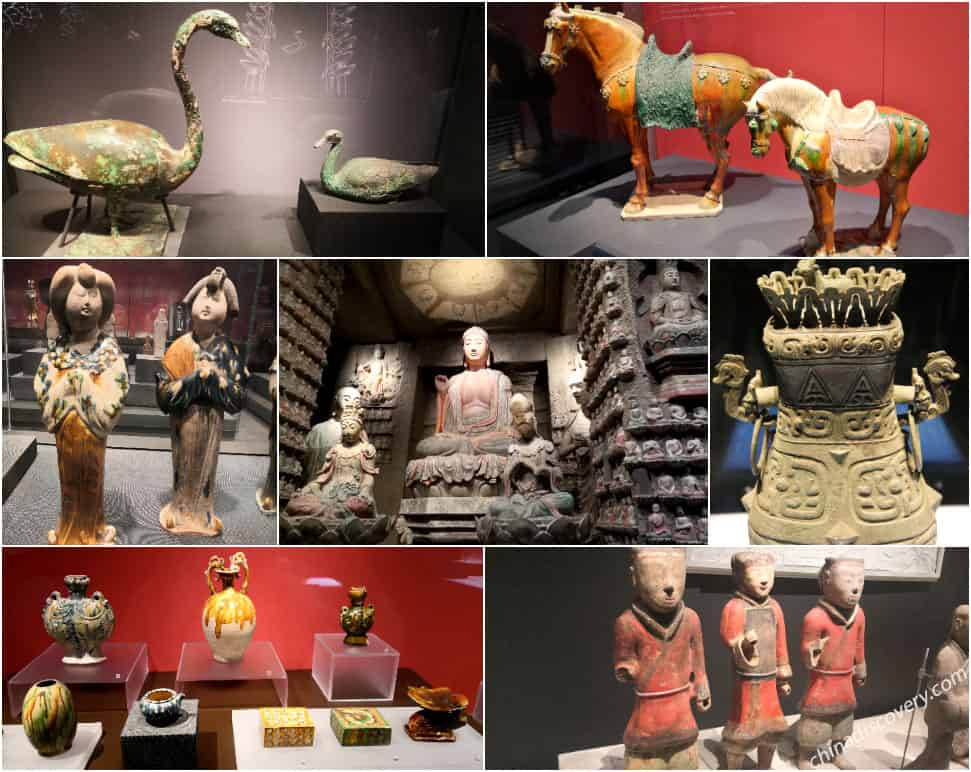
Built in: June 60,1991
Area: 650,000 sq m
Collection: 370,000 pieces(sets), 762 class A cultural heritages.
Masterpieces: 18 national treasures - The Empress'Jade Seal, Agate Cup with Gold Animal Head, Yu Tripod, Wei Ding, Duoyou Tripod from Western Zhou, Gold and Silver Bamboo Censer from Western Han, Silver Pot with Dancing Horse from Tang Dynasty, previous paintings from Tang Dynasty...
Open Hours: 09:00~17:30 (November 15~March 14) & 08:30~18:00 (March 15~November 14); closed on Mondays and Chinese New Year’s Eve, except public holidays.
Ticket: Free for the permanent exhibitions,daily free ticket is limited to 4,000, 2500 before 2500 and 1500 for rest time.
Location: No.91 Xiaozhai East Rd, Yanta District, Xian City, Shaanxi Province.
Recommended Visiting: 3 ~ 4 hrs
Located in western of Giant Wild Goose Pagoda, the Shaanxi History Museum, a integrative history museum, is a national first-class museum and the first large modern national museum of China. Co-build by central and local governments, it was rewarded as the architecture heritage of 20th century in China with ancient capital history for 13 glorious ancient dynasties. The abundant cultural legacy, profound cultural accumulation in special Shaanxi history and culture make Shaanxi History Museum a bright pearl, treasury of China and art palace presenting the ancient Shaanxi and Chinese civilization. In the museum, superb collected antiques that on over 1 millions years time scale covers numerous cultural relics in various types, high grade and significant value, including pristine stone implements used by ancient human ancestors, different artifacts of ancient bronze wares, pottery figurines, gold and silver works and unrivaled murals.
To convey the wealthy cultural connotation, Shaanxi History Museum runs multiform exhibitions to unfold the great achievement of Chinese nation in ancient times, which divided into Preface Hall, Permanent Exhibition, Topic Exhibition, Temporary Exhibition and international gallery in central hall five parts. Shaanxi Ancient Civilization, Tang Tombs Murals and Treasures of Great Tang Dynasty are the three must-see of Shaanxi History Museum.
Initially opened in 2008, the basic exhibition of Shaanxi Ancient Civilization reveals development of ancient social civilization through combinations of display of classic relics from each age in the halls covering 4600sq m. Seven parts of prehistory, Zhou, Qin, Han, Wei&Jin& Southern& Northern Dynasty, Sui&Tang, Song&Yuan&Ming&Qing in three halls highlights the top level of ancient Chinese economy with more than 2,000 valuable exhibits, including painted pottery, bronzes in Zhou, ancient weapons, architecture components from Qin, and gorgeous gold and silver wares in Tang. With an area of 4200sq m, the Tang Tombs Murals Hall on the first floor underground of east gallery shows about 600 fresco boutiques to 1000 sq m, which 18 (5 sets) paintings are noted as national treasure, 82 (69 sets) are first grade. Murals paintings unique style buildings, vivid figures and characteristic utensils, lively landscape here are important literature to research noble life of Tang Dynasty. Another major permanent exhibitions - Treasure of Great Tang Dynasty displays more than 30 sets of jades and jewelry found in Hejia Village in 1970, 466 Chinese coins made in gold, silver, copper and ancient Japanese silver coins, gold coins of Eastern Rome, including the well-known national treasure Agate Cup with Gold Animal Head from, wine vessel of Tang Dynasty.
Topic Exhibitions are mainly irregular displays on technical and professional themes. As a supplement for basic and topic exhibitions, the short but refreshing temporary exhibitions introduced in each year serves as an culture exchange and a cultural window for the society.
Notice: Paid services include the temporary exhibition, guide interpretation, the audio guide rent, parking, souvenirs, the book sales, catering services and so on.
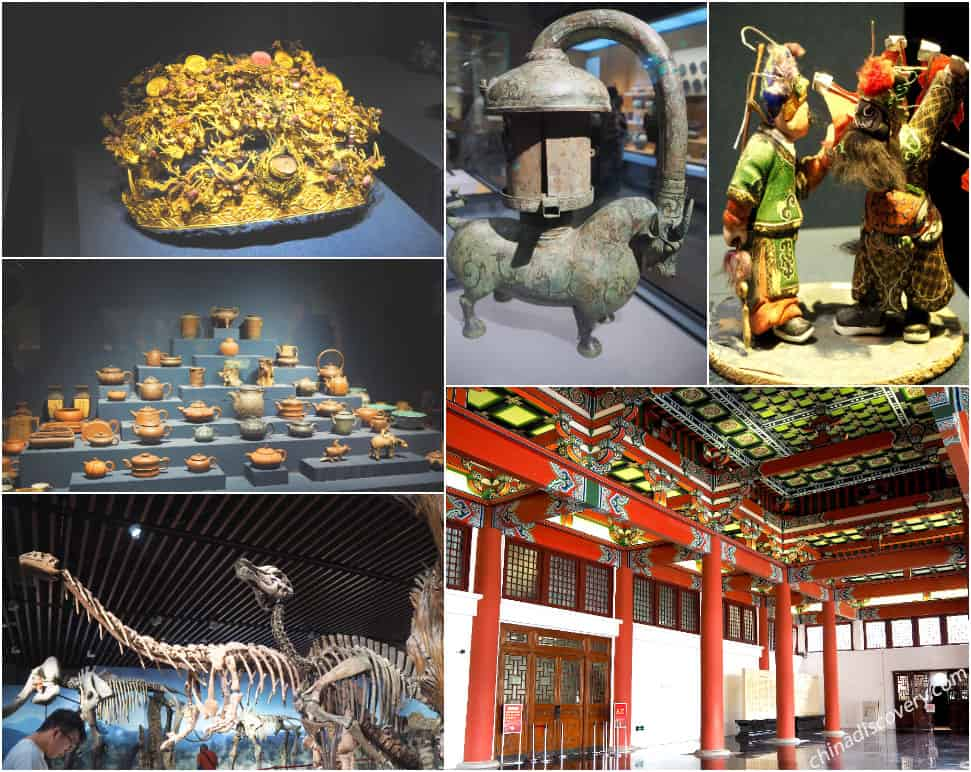
Built in: 1933
Area: 84,800sq m
Collection: more than 430,000 artifacts (sets)
Masterpieces: 18 national treasures - tringed jade ornament during Neolithic period, precious reticulated bronze pot, old coin of Chu during the warring states period, old beast in the Western Han Dynasty, ade Seal of Prince Guangling and cattle light with silver ornaments in the Eastern Han Dynasty, bronze inkstone bronze decorated with fine gold mosaic beasts in the Eastern Han Dynasty, celadon beast-shaped jar in the Western Jin Dynasty, seven hermits in the bamboo grove and Rong Qiqi pictorial molded brick in the Southern Dynasty, underglazed red vase with bamboo, pine and Chinese plum in Ming Dynasty and etc.
Open Hours: 9:00~12:00 (Monday) & 9:00~17:00 (Tuesday ~Sunday), opens on full Monday if it is public holiday, closed on Chinese New Year and New Year’s Eve
Ticket: Free of Basic Permanent Exhibitions and temporary exhibitions are charged.
Location: No.321 Zhongshan East Rd, Xuanwu District, Nanjing City, Jiangsu Province.
Recommended Visiting: 2 ~ 4 hrs
The former National Central Museum in 1933, the oldest museum of China, is the previous existence of Nanjing Museum - one of the Top three museums of China and the first large national comprehensive museum in China. It belongs to the eight national museums co-built from both central and local, where collections rank top three of China. Relics from Palaeolithic Age to contemporary era covers stoneware, crockery, jades, bronze ware, porcelain, painting and calligraphy, embroidery, folklore and art articles in high value of history and culture, cover 1,062 cultural relics higher than first national grade.
With over 80 years’ advance, now the Nanjing Museum forms a feature of six distinctive galleries within one museum building through adding the four galleries of Temporary, Republican Period, Intangible Heritage, and Digital Gallery based on the two galleries of Art and History. Every year, Nanjing Museum holds more than ten temporary exhibitions besides the basic, including theme exhibition of collection, essence exhibition of cultural relics from other provinces, modern art exhibition.
Gallery of History is composed of six exhibition halls, three on the first floor and three on the second. The Display of Jiangsu History is the basic exhibition in Gallery of History with nearly 3,000 archaeological and ethnological relics and literatures exhibiting political, economic and cultural processing of Jiangsu Province. The newly built Gallery of Temporary is aimed at temporary display and special shows to exchange between various cultures and arts within the ten halls. In the eights halls of Gallery of Art, there are classified themed exhibits of ancient painting, calligraphy, sculpture and special halls for famous artists, such as the great Chinese Painting artist Fu Baoshi, claborate-style painter Chen Zhifo and oil painting master Su Tianchi. Themed architectures of old restaurant, tea house, newspaper office, post office, theatre and railway station in Galley of Republican Period make the visitors pass across the time and space to see the original people living during the Republican Period. Turn to the Gallery of Intangible Heritage, apart from the intangible cultural heritages of Jiangsu Province, some dynamic show of popular folk activities, traditional handicraft and verbal performance are still valuable cultural legacy should get attention and well protection. If you wants tour Nanjing Museum anytime, the Digital Gallery consisting of two parts in reality and online creates a virtual pavilion like the real one but never close, making the ancient civilization of Jiangsu exhibited online.
Notice: Only the basic permanent exhibitions and themed exhibitions of collections are opened to the public free of charge, organized temporary exhibitions and shows are excluded in the free tour of Nanjing Museum.
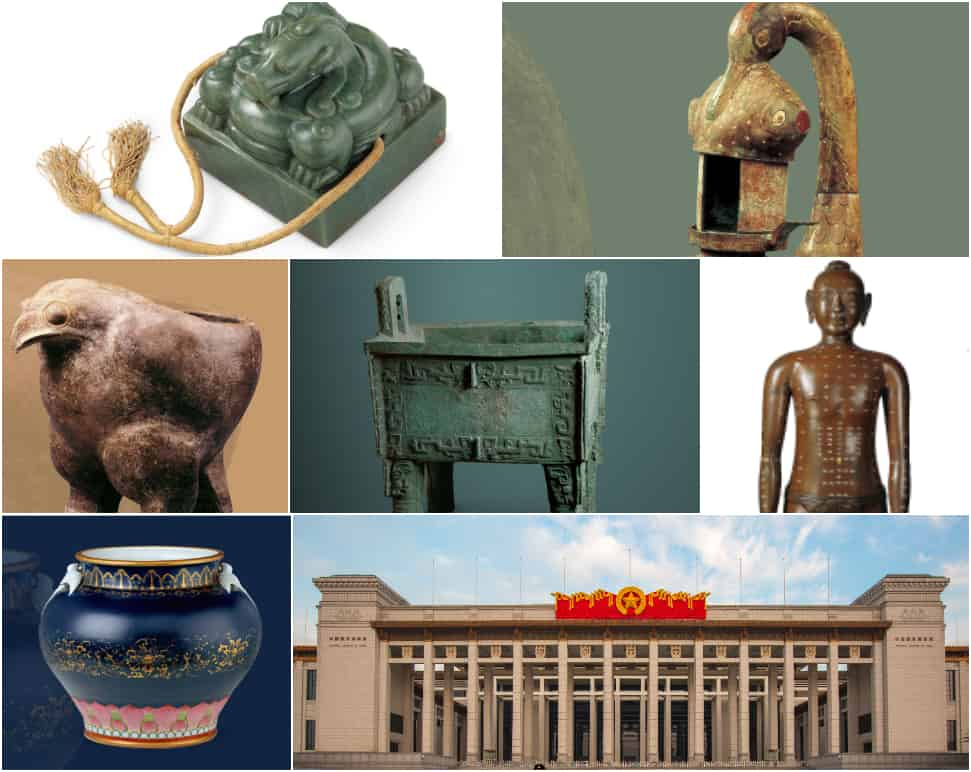
Built in: August, 1959
Area: about 200,000 sq m
Collection: over 1,300,000 pieces
Masterpieces: Basin with A Fish Pattern with A Human Face, Da Yu Ding, Jade Dragon, Jade Showing A Stork with A Fish and A Axe, Zilong Cauldron (Ding), Houmuwu Square Cauldron (Ding), Tiger Pattern Chime Stone and more ancient national treasures...
Open Hours: 09:00~17:00; Closed on Mondays (including public holidays).
Ticket: Free Visiting (from west gate), except special exhibitions.
Location: No.16 East Changan Street, Dongcheng District, Beijing City (East side of Tiananmen Square).
Recommended Visiting: 3 ~ 4 hrs
Merged from the Chinese History Museum and Museum of Chinese Revolution in 2003, National Museum of China is the largest museum of single building area in China and the world’s top popular cultural architecture rich in profound historic and cultural heritages. Famous for the comprehensive status with collection, exhibition, research, archaeology and public education, the National Museum has become the ancestral hall for Chinese Civilization, the Cradle of Chinese Dream where records over 5000 years' history and culture of China and preserve countless national treasures, the sublime spiritual homeland Chinese people inherit history and develop future. It is an important dialogue channel with the world, a magnificent palace showing brilliant achievements of historical and cultural arts and social development of the entire human civilization.
As one the Chinese museums with affluent relic collections, the 5-storied building highs 42.5 m with 48 exhibition halls, and huge Lecture Hall, Theatre, library and public leisure space. Except permanent exhibitions including Ancient China and The Road of Rejuvenation , National Museum of China holds plenty of long-term theme exhibitions, like Ancient Chinese Buddhist Sculpture and Ancient Chinese Bronze Art (both in No.2 Central Hall on F3), Exhibition for Fan Painting of Ming & Qing Dynasties, Collection of Architectural Design, Ancient Chinese Jade Art, Ancient Chinese Money and etc in North and South Galleries.
On basement level one, the permanent Exhibition of Ancient China including eight periods of Ancient Time, Xia & Shang & Western Zhou, Spring & Autumn Period, Qin & Han Dynasties, Sui & Tang &Five Dynasties… presents the long development of Chinese Civilization via 2026 valuable exhibits, 521 first grade cultural relics along with the ancient dynasties alternation. Major heritages of Ancient China encompasses various antiques used by Yuanmou Man, Peking Man in far Stone Age, masterful bronzes from early dynasties of Xia, Shang and Western Zhou, Langya Caved Stones, Painted terracotta warriors from powerful Qin and Han, and sophisticated typical artifacts in all kingdoms. Public Service area, Lecture Hall and Theatre, Broadcasting Room are on the same location.
Up to the first floor, there are North Galleries (N1~N4), South Galleries (S1~S5) and another permanent Exhibition of the Road of Rejuvenation on both sides of the Central Hall 1. Modern China and Contemporary China are the two basic displays which retrospect the general development during the 100 years history of China from the First Opium War in 1840 to the establishment of PRC in 1949 with more than 2300 objects, literatures, restored sites.
Exhibition of the Road to Rejuvenation continues in larges galleries on the 2nd floor, and more North Galleries (N8~N11) and South Galleries (S6~S10) are set up here. On the 3rd floor, there are Central Hall 2, North Galleries (N16~19) and South Galleries (S11~S14). Besides, the Experts Building for professional researchers stands in the specialized floor with Lecture Hall and Theatre.
More Popular Theme Exhibitions in National Museum of China:
Date: December 10, 2017~December 20, 2017
Venue: Gallery S1 on basement one
Date: Theme Exhibition (Permanent)
Venue: Public Area on F3
Date: On Regular Display
Venue: Gallery N17
Date: On Regular Display (opened from September 26, 2013)
Venue: Gallery N9
Notice: No flashlight, tripods are forbidden to use when taking photos. Photo permission for introduced temporary exhibitions will be reminded with clearly signs at entrance and within the exhibition halls.
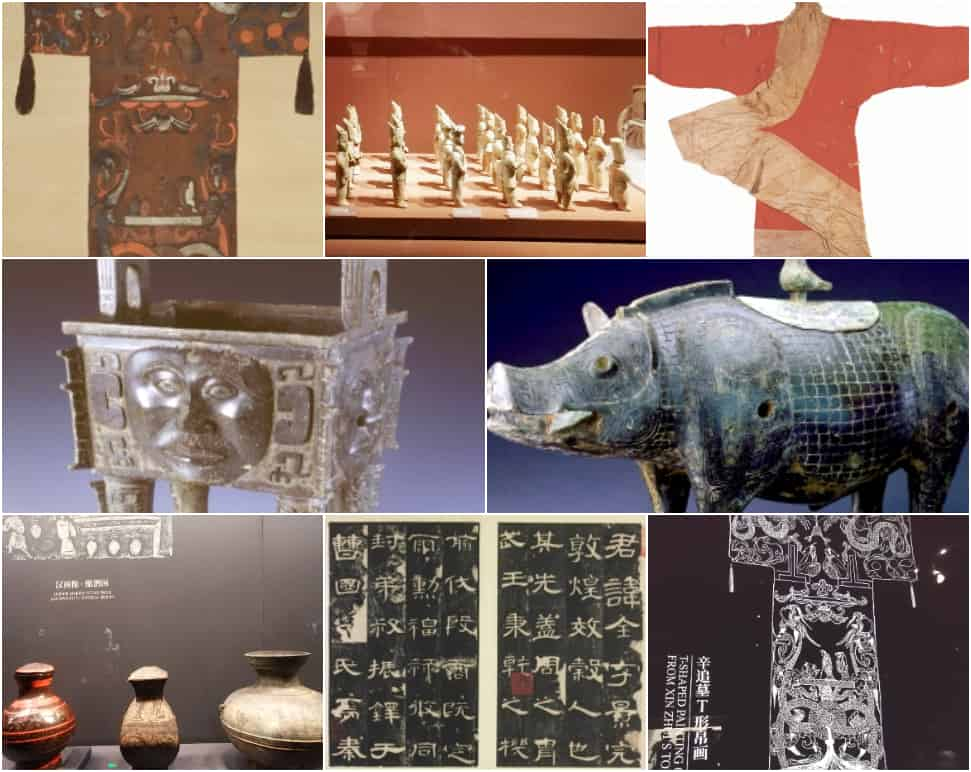
Built in: 1951
Area: 91,000 sq m
Collection: over 180,000 relics
Masterpieces:seven treasures - Plain Unlined Gauze Gown & T-shaped Silk Painting from Western Han, Silk Painting with A Figure Driving a Dragon, Boar-shaped Bronze Zun, Coffin with Painted Designs on Black Lacquer Coating, Bronze Ding with Human-mask Design, Copy of Preface to the Poems Composed at the Orchid Pavilion in Tang Dynasty.
Open Hours: 9:00~17:00 (Tuesday ~ Sunday); Closed on Mondays and Chinese New Year’s Eve except public holidays.
Ticket: Free Ticket, daily capacity up to 15,000 visitors.
Location: No.50 Dongfeng Rd, Kaifu District, Changsha City, Hunan Province.
Recommended Visiting: 2 ~ 3 hrs
Five years’ quality expansion brings us a brand new Hunan Museum, the largest historical museum of fine arts of Hunan expressing ancient culture. In the afternoon on November 29, 2017, the Hunan Museum - one of the eight national museums co-constructed by central and local governments reopened to the public, again people get good accesses to know about the civilization development of Hunan and appreciate the profound culture mystery.
Layout of Hunan Museum contains five floors and one basement underground with two permanent exhibitions (Mawangdui and Hunanese) and four themed exhibitions (about bronze, ceramics, calligraphy and paintings, crafts) to present excellent human cultural heritages. The Top is the Multi-function Hall, and visitor restaurant and roof garden is on the fourth floor. Themed Exhibition and Changsha Mawangdui Han Dynasty Tombs Exhibition is on the third floor. Three old tombs from West Han Dynasty were unearthed from 1972 ~1974, the highly complicated tomb structure and rich burial objects including silks, manuscripts, silk paintings, lacquer, pottery, seals, Chinese herbal medicines and etc. up to over 3000, making it one the most significant archaeological finds in 20th century.
On floor 2, the Hunanese Exhibition next to Education center is the special local history and culture exploration of natural livings and civilization process. It comprises of five parts, Home, Where Do I (Hunan) Come from - Huzhua Mountain Ruins, Wealth of Lake Dongting, Trace of Everyday Life - Minfang Lei Urn-shaped Bronze Wine-Vessel, a national treasure reunited with pieces bought from overseas in 2014 and Spirit of Hunan showing the heptachord of Tan Sitong. There two temporary exhibition galleries on the left and middle front facing the main entrance, Mawangdui Tombs Exhibition and academic auditorium, book store, VR experience area and shop on the first floor.
Notice: The best visiting route is go to the Hunanese Exhibition on 2rd floor firstly and then the Mawangdui Exhibition on the third floor.
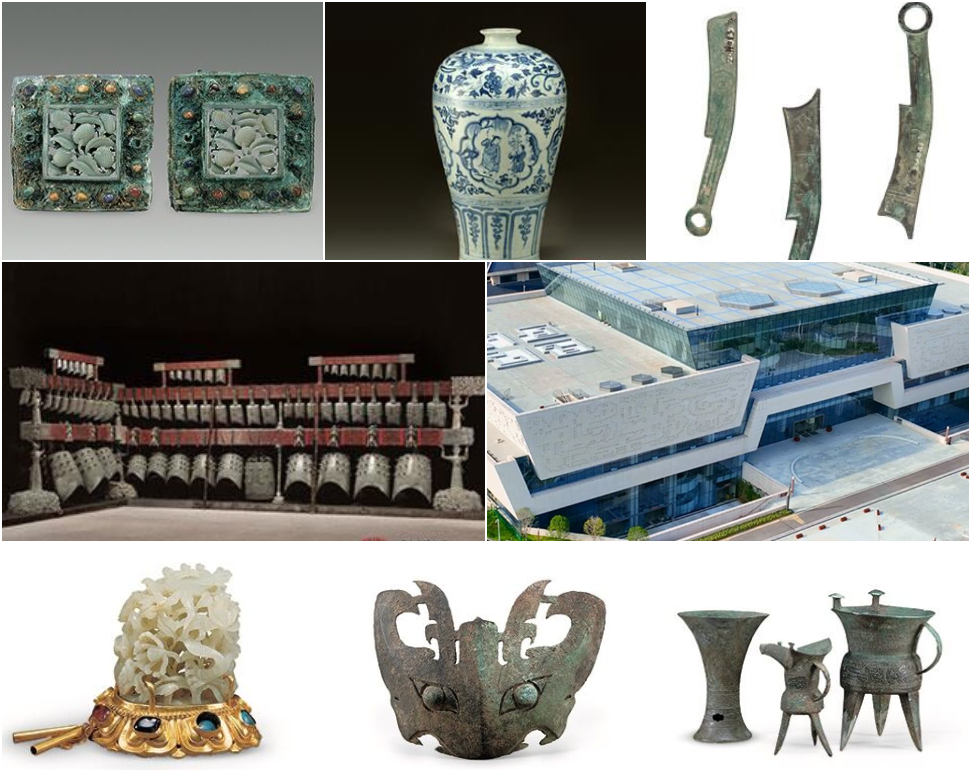
Built in: 1953
Area: 81,909 sq m(8000sq m for exhibitions, 5717 sq m for Chime Hall)
Collection: over 240,000 pieces (sets), about one thousand national first grade relics.
Masterpieces: four boutiques – The Sword of Goujian, Chime-bells from the Tomb of Marquis Yi of the Zeng State, Human Skull Fossil from Yun County, Blue and White Plum Vase of the Four Loves in Yuan Dynasty.
Open Hours: 9:00~17:00(Tuesday ~Sunday); Closed on Mondays, Chinese New Year’ Eve except public holidays.
Ticket: : Free Visiting (from west gate), except special exhibitions.
Location: No.160 Donghu Rd, Wuchang District, Wuhan City, Hubei Province.
Recommended Visiting: 2 ~ 3 hrs
Once named by the Vice President Dong Biwu in 1960, Hubei Provincial Museum is a national first-class museum and one of the eight state museum jointly built by central and local governments. It is an AAAAA scenic area, key scientific research base for lacquerware protection and the largest museum with the most collections and the superior scientific strength.
Apart from the great tour treasures, there collects large number of relics discovered, distinctively local and present the ancient society of Hubei, such as the precious eggshell painted pottery of spindle wheel from Qujialing Culture in Neolithic Period, Jade human and hawk from Tianmen Shijia Ruins, the large jade Ge and bronze tripod excavated in Panlong City.
Currently, Hubei Provincial Museum opens about 10 permanent exhibitions, each year introduce some temporary exhibitions like the Buddha Exhibition of Buddhist Art of Gandhara, and occasional domestic or foreign exchange exhibitions. Extension cultural performance of Chime Pay and Dance won high compliment since it shows to the public the grand ancient royal singing and dancing scene reproduced on the modern stage.
Found in 1978, Tomb of Marquis Yi of Zeng is the emperor tomb with 2400 years, and over ten thousand of well-reserved relics were discovered here, quite a stir in the world then. Exhibition of Chu Culture is the quintessence exhibition of the Chu tombs, presents a full picture of the splendid material and ideological culture of the Chu people. A gold ingot exhibited in the Tomb of Prince Liangzhuang is the treasure proved the story of Zheng He travelling to West Ocean. More 7 exhibitions includes lacquered articles in the Qin & Han Dynasties, luminaries of Hubei during a century, porcelain, Jiuliandun, Panlong City and etc all explain the marvelous ancient culture in writing, ceramic, lacquer, bronze.
Notice: The museum offers some free of charge seasonal Rites and Music lessons for people interested in.
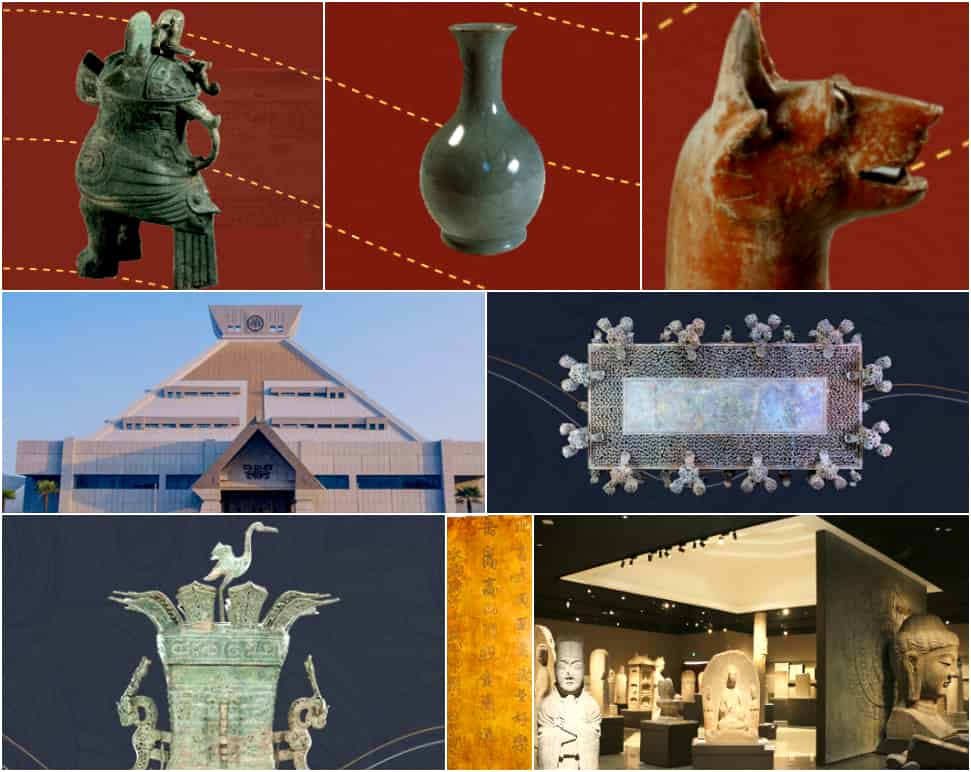
Built in: 1927
Area: 100,000 sq m
Collection: about 140,000
Masterpieces: Nine Treasures - Bronze Wares (Lotus and Crane Rectangular Pot, "Fuhao" Owl-shaped Zun, Duling Rectangular Ding, Cloud Design Jin) & Gold slip for Absolving Sin, Iron Sword with Jade Haft, Jiahu Bone Flute (the earliest musical instrument), Mural Painting of Four Animals in Clouds, Sky Blue Glaze Ru Kiln Vase.
Open Hours:9:00~17:30 & 9:00~17:00 in Winter; Closed on Mays except public holidays.
Ticket: Free Ticket
Location: No.8 Nongye Rd, Jinshui District, Zhengzhou City, Henan Province.
Recommended Visiting: 3 ~ 4 hrs
Henan Museum is one of the oldest museums of China and a first national museum constructed by central and local government. The brand new site was removed several time from Kaifeng to Zhengzhou and reopened in May 1 1998 as one of the great comprehensive museum in China, collecting more than 5000 pieces of First and Second Grade Cultural Relics.
All architecture of the museum is well-constructed in grandiose, primitive and elegant shape with unique artistic style, excellent embodiment of Central Plain Culture. Such as the pyramidal main pavilion in the center location is the most important exhibition gallery, other buildings for comprehensive service and business, training and relics storeroom lies in the neighborhood.
In 2009, the former exhibition halls get upgrade into a permanent exhibition hall Ancient Astronomy and four theme galleries and special exhibitions. In the Ancient Astronomy, there are eight exhibition halls, the four of Primitive Society, Xia & Shang Dynasty, Western Zhou and Eastern Zhou are on the floor one, the rest four including Western Han and Eastern Han Dynasty Hall, Han Jin Dynasty Hall, Sui & Tang Hall and Song & Yuan Dynasty Hall are on the second floor.
The four theme exhibition halls are the gallery showing multiple relics. The Chu State Bronze Hall largely display the bronze treasures founded in the nobles tombs during Chu of Henan. Cloud Design Jin here is the earliest cast article made in method of cire purdue. Jades from the Ancient Jade Article Hall express the rich Central China's jade culture during Xia, Shang, Zhou Dynasties for thousands of years. Porcelain, embroidery, ivory carving, lacquerware, gold and silver qntiques in the Ming & Qing Treasure Hall is the glorious development of ancient China. Ancient Stone Carvings Hall reserves attractive stone portraits of Han Dynasty discovered in Nanyang and Shangqiu of Henan.
Notice:
1. In order to make the best protection of visitors and relics, the maximum daily capacity is limited up to 5000, 3000 in the morning and 2000 in the afternoon.
2. Chinese Guide Interpretation is charged 100RMB or 80RMB based on the working experience of interpreter, and English Guide Interpretation is 150RMB.
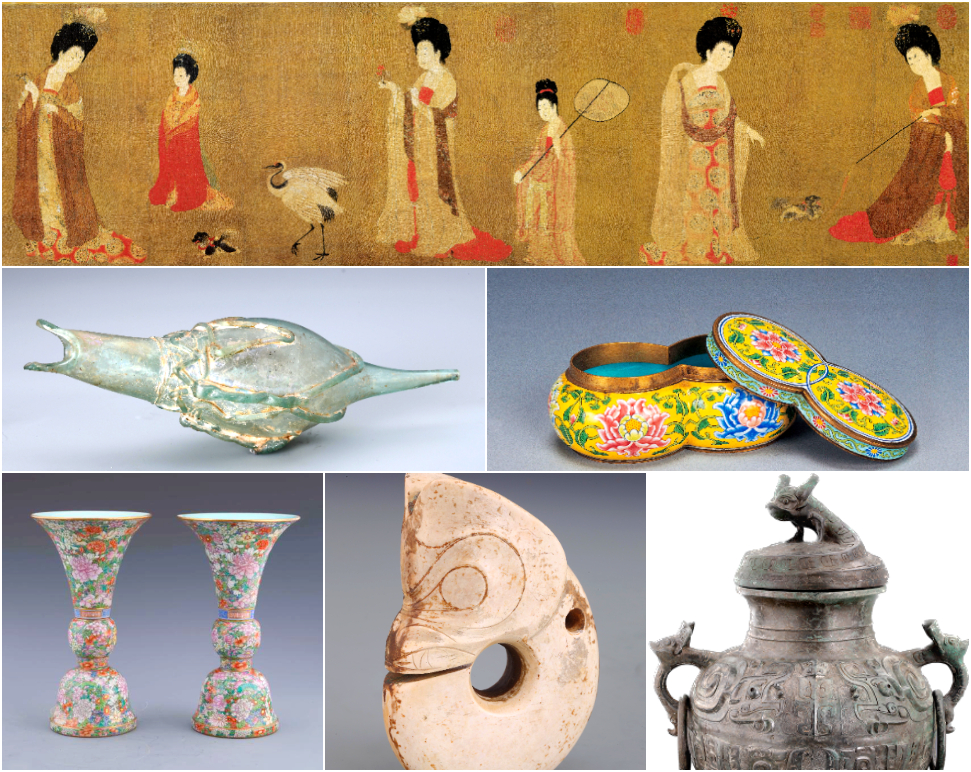
Built in: July 7, 1949
Area: 83,200sq m
Collection: 112,000 artifacts (sets)
Masterpieces: Calligraphy (the Eulogy to Cao E, Unknown Copy by Wang Xizhi, Cursive Script & Four Ancient Poems of Zhang Xu) & Painting (Cranes of Zhao Ji – Huizong of Northern Song Dynasty) & Epitaph & Bronze Wares
Open Hours: 9:00~17:00 (April~October) & 9:30~16:30 (November~March); Closed ont Mondays and Chinese New Year’s Eve except public holidays.
Ticket: Free Visiting
Location: No.157 Zhihuisan Street, Hunnan New District, Shenyang City, Liaoning Province.
Recommended Visiting: 2 ~ 3 hrs
Won the most honorable China Building Construction Luban Awards in 2014, the newly built Liaoning Provincial Museum is the first museum of PRC and the biggest one in northeastern China. For historical reasons, essence of Liaoning Provincial Museum is the Ming and Qing Jades in high quality and most variety in China. After long period of repair and expansion, currently the three-stored building establish five areas covering 42,979 sq m of 22 exhibition halls, only opens the six exhibition halls on the first floor to the public.
Much bronze relief sculptures themed long history of Liao are created on the walls to reveal the brilliant culture in the past. Exhibition halls on first floor (8739sq m) are mainly used for exhibitions of historical and cultural relic introduced from domestic and abroad, and more halls hold exhibitions of collected items like the Ancient Chinese Epitaphs, the Porcelain Wares of the Ming and Qing Dynasties and the Jades of the Ming and Qing Dynasties, Treasure Exhibition of Tibet Fine Cultural Relics.
As for halls on the second floor are planning to exhibit the collected Liao porcelain wares, currencies, Buddhism statue, royal seals, bronze mirrors and Manchu folk custom, including temporary exhibitions of Select Ceramic Ware of Liao Dynasty and Buddha statue of ancient China. On the third floor, five halls are set to hold cultural relics including calligraphy, painting and silk embroideries.
Visitor Centers (11171sq m) includes multimedia report hall, audience interactive exploration area, volunteer center and souvenir store. One floor below is the Cultural Relic Warehouse (10019sq m). Area of Cultural Relics Preservation (7456sq m) is the work site for experts to restore relic. The Comprehensive Business Area (13110 sqm) mainly consist of display center, information center, cultural exchange center and library.
Notice: Optional services like irregular guide explanation, books and souvenirs needs to be paid within the museum.

Built in: April 16, 2007(open date)
Area: 300,000 sq m
Collection: over 10,000 items, more than 6,000 precious cultural relics.
Masterpieces: Gold Wares(Mask, Belt)& Jade Ware & Sun and Immortal Bird
Open Hours: 8:00 ~20:00 (May ~ October) & 8:00~18:00 (November ~ April); Closed on Mondays except Jan, Feb, Jul, Aug and Public Holidays.
Ticket: 80RMB per person
Location: No.2 Jinshayizhi Rd, Qingyang District, Northwest Chengdu City; about 25km to Shuangliu International Airport & 6km to Chengdu Railway Station.
Recommended Visiting: 2 ~ 3 hrs
Built on the Jinsha Ruins (the oldest site in Chengdu), Chengdu Jinsha Site Museum is a modern garden museum displaying the ancient Shu Culture of Sichuan during Shang and Zhou Dynasties and a landmark in Chengdu City. Ruins Gallery and Exhibition Hall constructed on slopes are the two major architectures of Jinsha Site Museum, which the slowly rising site. Design of the Ruins Gallery in circular, exhibition building in square are the best two symbol of the cosmology ancient people thought universe is orbicular and earth is rectangular.
Ruins Gallery facing Qingyang Avenue of East Gate is the site where found the huge places to offer sacrifice of Jinsha Ruins, and it is the best reserved big site holding worship ceremony in China. The showing of original discovery, huge tree roots not only keep the integrity and authenticity of relics but also bring visitor visual shocks. Here is the perfect scene to truly feel grandiose ancient sacrifice and closely look the Archaeological works.
Site Exhibition Hall in the north includes five halls and a 4D cinema on the two floors and one basement. Hall No.1 is Primitive Homeland (900sq m) located in the west hall on 2nd floor. Together with the well-designed live-action, the diorama presents a actual living environment of ancestors from 3000 years ago. King Palace at a Glance (900sq m) is Hall No.2 in eastern hall of the second floor shows the lives sketches of residence, tools, tomb, making pottery and etc of ancient Jinsha people, through hi technology in scenes recovery. On the first floor, Immortal Heaven & Earth (1000sq m) in the east exhibits much exquisite artifacts like gold, bronze, jade, stone, ivory in the dim light, which illustrate the once resplendent and fantastic country. Peak of Perfection in the west 1st floor is the highlight where assemble over 30 boutiques like the noble gold wares, mysterious bronzes, gorgeous jadeware and stones. The 4D cinima is next to the Hall No.3 - Immortal Heaven & Earth. Underground Seeking of Mysteries of Jinsha (800sq m) shows the close connection among Jinsha Culture and Baodun Culture, Sanxingdui Culture and around Shu cultures. Northwestern Jinsha Theatre is where the first China huge original musical - Jinsha holds.
Actually, China has thousands of museums, including massive of fantastic museums for you to discovery, whether you are a Chinese ancient history lover, or a huge fan of Chinese culture, you can always find a best museum to get all you want. Except the above top 10 best-known museums in China, there are more themed culture galleries located in different Chines cities, such as the specialty museums - Suzhou Silk Museum, China National Tea Museum, Chongqing Three Gorges Museum and significant local museums - Zhejiang Provincial Museum, Anhui Musuem and Gansu Provincial Museum, historical museum on ruins - Yin Ruins Musuem, Terra-Cotta Warriors Museum and etc.
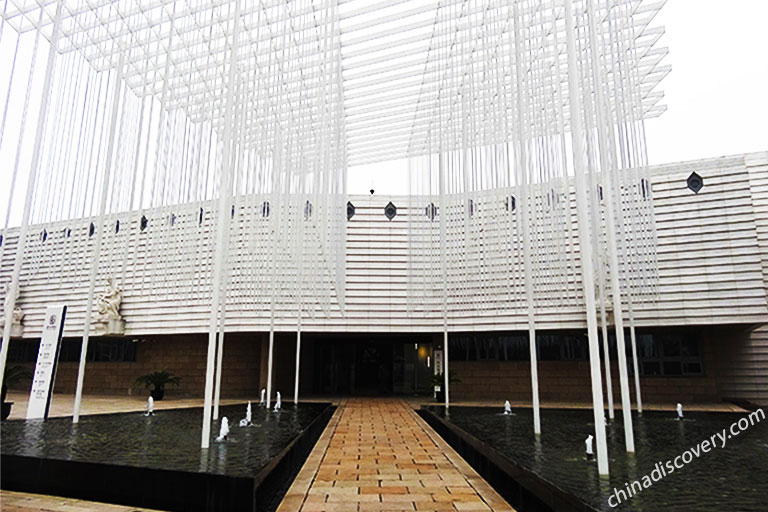 Suzhou Silk Museum in Jiangsu Province
Suzhou Silk Museum in Jiangsu Province
Top 3 tours chosen by most customers to explore in the best way. Check the detailed itinerary, or tailor your own trip now with us.
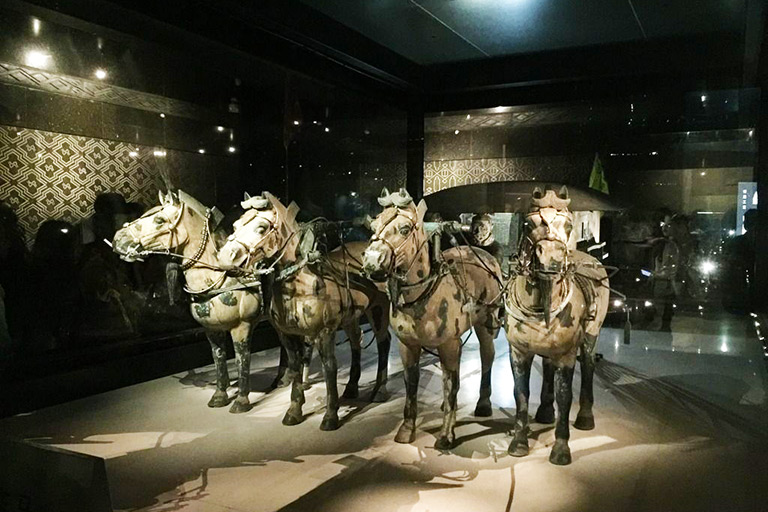
Beijing / Xian
Start planning your tailor-made holiday to China by contacting one of our specialists. Once inquired, you’ll get a response within 0.5~23.5 hours.
Customize a Trip